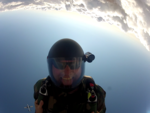grimmie 173
Some DZ's are surrounded by some pretty high hills.
If I was at Lost Prairie that might be a good idea.![]()
That altitude was for students. I think the reasoning is that as a student we were taught that if we didn't have a properly functioning canopy by 2500' to go to EP's. So exiting on a main lower than 3000' feet as a student doesn't give much time before the 2500' EP hard deck. I understand what you are saying though, seems a bit high to go to your last option. I would also be interested in seeing what the general consensus of what a good hard deck for pulling the reserve on exit is in an emergency situation.
DeNReN 0
QuoteQuoteI was instructed that in an emergency if below 3000' feet to go straight to reserve, any higher pull my main.
I don't have my "I" rating, but I think that's an unnecessarily high hard-deck for a true "clear & pull", even for a student, even in these days of higher pull altitudes and snivelly canopies. What do you instructors out there (especially the long-timers) think?
As per the USPA SIM, minimum opening altitude for students is 3000ft.... so instructing a student to go to reserve on a 3000ft exit is not unwarranted....
Andy9o8 0
QuoteQuoteQuoteI was instructed that in an emergency if below 3000' feet to go straight to reserve, any higher pull my main.
I don't have my "I" rating, but I think that's an unnecessarily high hard-deck for a true "clear & pull", even for a student, even in these days of higher pull altitudes and snivelly canopies. What do you instructors out there (especially the long-timers) think?
As per the USPA SIM, minimum opening altitude for students is 3000ft.... so instructing a student to go to reserve on a 3000ft exit is not unwarranted....
That's with a planned jump, not a pilot-instructed emergency exit, and that also contemplates the scenario of deploying at 3K at terminal, not "count-to-two-and-pull".




I don't have my "I" rating, but I think that's an unnecessarily high hard-deck for a true "clear & pull", even for a student, even in these days of higher pull altitudes and snivelly canopies. What do you instructors out there (especially the long-timers) think?
Share this post
Link to post
Share on other sites